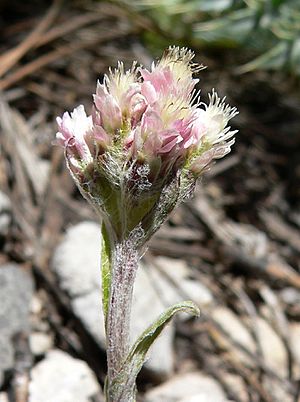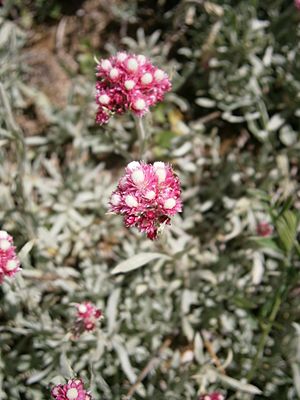Rosy pussytoes facts for kids
Quick facts for kids Rosy pussytoes |
|
|---|---|
 |
|
 |
|
| Scientific classification | |
| Genus: |
Antennaria
|
| Species: |
rosea
|
The rosy pussytoes (Antennaria rosea) is a type of flowering plant found in North America. It belongs to the daisy family. People also call it cat's foot or mountain everlasting. This plant grows in many places across Canada, including its Arctic regions, and also in Greenland. You can find it in the western and central parts of the United States, and even in the Mexican state of Baja California.
Contents
About Rosy Pussytoes
Rosy pussytoes can live in many different places, from dry areas to wet ones, and from low lands to very high mountains. This plant can look quite different from one plant to another. It's special because it often has more than the usual number of chromosomes, and it can make seeds without needing pollen from another plant. This means most rosy pussytoes plants are female and they reproduce without a partner.
What Does the Rosy Pussytoes Plant Look Like?
This plant is a herbaceous perennial, which means it's not woody and it lives for more than two years. It usually grows to be about 10 to 40 centimeters tall. It has short stolons, which are like underground stems, that help it spread and grow new plants. This is how it reproduces without seeds.
The plant forms a patch of soft, grayish leaves at its base. These leaves are usually 1 to 4 centimeters long. The plant's flowers grow in a cluster of several flower heads. Each flower head has wide, pointed leaf-like parts called phyllaries. These phyllaries are often a pretty rose color, which is how the plant got its name, "rosy pussytoes." Sometimes, they can also be white, yellowish, or brownish.
Most rosy pussytoes plants are female, so their flower heads usually have female parts that can produce seeds. The fruit of the plant is very small, less than 2 millimeters long. It has a fluffy top called a pappus, which helps the fruit fly away in the wind.
How Rosy Pussytoes Reproduce
Even though the plant can make fertile seeds, most individual plants in a group are actually clones. This means they are exact copies of the parent plant. Sometimes, pollen from other Antennaria species can fertilize rosy pussytoes. This can bring new genes into the plant group, which helps create more variety among the clones.
Rosy Pussytoes in Gardens
In the United Kingdom, the rosy pussytoes plant has received a special award called the Royal Horticultural Society's Award of Garden Merit. This award means it's a great plant for gardens.
Types of Rosy Pussytoes
There are a few different types, or subspecies, of Antennaria rosea:
- Antennaria rosea subsp. arida
- Antennaria rosea subsp. confinis
- Antennaria rosea subsp. pulvinata
- Antennaria rosea subsp. rosea

